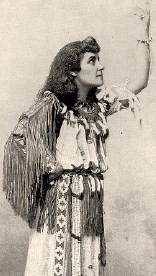Spadina Literary Review — edition 4 page 03
re verse
Tekahionwake's bad hair day
by Ian Allaby
This past March marked the hundredth anniversary of the death of E. Pauline Johnson, also known as the Mohawk Princess, also known as the Mohawk Poetess, and, finally, also known as “Tekahionwake,” which was the nom de théatre she adopted in 1890 when, at age 29, she donned an Indian costume and launched a career reciting poetry, her own poetry, from the stage. She managed to maintain that career for close to two decades. Tekahionwake was by all accounts a passionate recitalist.

Hey, Tekahionwake,
where you going with
that scalp on your belt?
She was born on the Iroquois Six Nations Reserve on the Grand River in southwest Ontario. Her mother was an Englishwoman. Her dad, Chief George Johnson, was a chief of the Mohawk, the largest of the Iroquois tribes, and was an important intermediary between the Six Nations and the Canadian government. The family home, called Chiefswood, on the banks of the Grand, had two identical entrances, one opening to the river, which was notionally the Mohawk path, and the other opening to the inland road, notionally the white man's path.
The name “Tekahionwake” represented her Mohawk half, and she used it alongside her English name in most performance venues. "Tekahionwake" meant something like “two wampums” or “two rivers” or “two pathways.” You can pronounce it Degga-hewn-woggy, assuming you are not a Mohawk speaker.
That “Indian costume” Tekahionwake wore, however, represented no known tribe. It was a pastiche of signifiers that would be read as “Indian” by her white audiences. She entered the stage in a buckskin skirt and top, the right sleeve a thick curtain of ten-inch fringes, the left a few shreds of rabbit fur. A string of bear claws guarded a neckline that was low-cut for the times. The numerous dangling accessories included beads, medallions, wampum belts, and a Huron scalp — the latter being an heirloom (no pun intended) from her grand-dad on the Mohawk side. Assuming the scalp was genuinely Huron and had been taken in battle, it likely traced back much further than her grand-dad.
Tekahionwake got her show off to a rootin’-tootin’ start with her “Indian poems” — those the Vancouver Province had in mind when it noted years later that many of her works revealed what it called “a thread of savagery that betrayed her origin.” Tekahionwake played up the “savage” angle herself by accentuating her verse with war whoops and death cries. Audiences were no doubt impressionable in that era, which was before the movies came in, and long before TV.